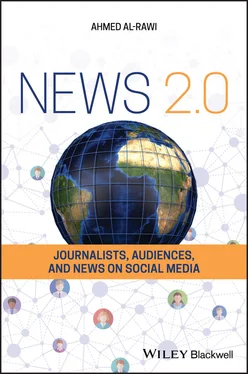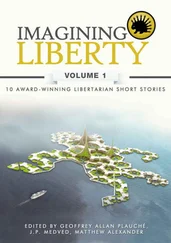Table 1.1 Facebook news pages and frequency of total reactions.
| No. |
Page |
No. of posts |
Total reactions |
| 1) |
CNN Arabic |
9993 |
739 369 |
| 2) |
The Guardian |
3241 |
1 963 470 |
| 3) |
The Independent |
6663 |
5 737 015 |
| 4) |
Youm 7 (  ) ) |
9995 |
3 547 479 |
| 5) |
Al Arabi |
7081 |
1 328 947 |
| 6) |
Hufftington Post‐Arabi |
8366 |
2 022 548 |
| 7) |
RT Arabic |
9888 |
9 198 863 |
| 8) |
DW Arabic |
9965 |
8 263 656 |
| 9) |
Fox News |
7070 |
164 201 316 |
| 10) |
Al Jazeera Arabic |
9740 |
36 529 076 |
| 11) |
The Daily Mail |
4195 |
5 128 176 |
| 12) |
SkyNews |
2166 |
1 299 939 |
| 13) |
SkyNews Arabia |
9936 |
10 936 313 |
| 14) |
France24 |
1657 |
107 467 |
| 15) |
BBC News |
3846 |
7 914 869 |
| 16) |
DW |
7956 |
827 397 |
| 17) |
France24 Arabic |
856 |
942 889 |
| 18) |
RT |
537 |
633 818 |
| 19) |
XinhuaNewsAgency |
9983 |
1 805 994 |
| 20) |
The New York Times |
3128 |
10 005 958 |
| 21) |
CNN |
5675 |
20 063 233 |
| 22) |
CBC News |
9981 |
3 519 474 |
| 23) |
The Washington Post |
2283 |
953 095 |
| 24) |
Al Jazeera English |
3363 |
2 743 514 |
| 25) |
BBC Arabic |
6755 |
6 152 507 |
| 26) |
The Hufftington Post |
3525 |
19 691 082 |
| ‐ |
Total |
157 844 |
326 257 464 |
From the perspective of news consumers, I examine a variety of metrics, such as YouTube video views, number of Facebook comments, likes, and retweets. Here, the fact that some stories get viewed, commented on, liked, or retweeted more than others signifies that they are important, since online audiences not only select news articles to read but also disseminate them by liking or commenting on them. This activity can be linked to the concept of produsage (Bruns 2007; Horan 2013) because of its dual nature. According to Facebook, clicking like is an indication that someone is interested in a post or a story, which will also “be posted on [his or her] Timeline” (Facebook 2019), so liking a news story shows engagement and reflects a certain degree of interactivity with the online material. Indeed, human beings may have a variety of motives for viewing, liking, and commenting on social media posts, such as indexing materials in order to consume them at a later stage or showing engagement with certain types of materials in order to express certain political ideas or stances. Facebook likes and comments are similar to retweeting a story or sharing a YouTube video, since a user's preferences can be seen and read by their friends or followers on the site. In this way, the shared, liked, or commented‐on news story is more likely to appear on the user's social media timeline, allowing their friends and followers to further engage with the story.
In view of the rapid developments in the news industry and new technologies, I argue here that we have in fact entered the era of “News 3.0,” part of “Web 3.0,” a term coined by Manuel Castells to refer to “the cluster of technologies, devices, and applications that support the proliferation of social spaces on the Internet thanks to increased broadband capacity, open source software, and enhanced computer graphics and interface, including avatar interaction in three‐dimensional virtual spaces” (2011, p. xxvii). Many news organizations have recently employed new technologies in producing and disseminating news, taking advantage of advances in algorithmic, automated, and robo‐journalism that often involve the “use of computer software ( Natural Language Generation [NLG]) to transform data and other material into a story that resembles a piece of human journalism, by following a pre‐programmed structure and formula” (Harcup 2014). The Los Angeles Times , for instance, was the first newspaper to publish an automated story about an earthquake in 2014 with the help of a robot “journalist.” China's Xinhua news agency introduced artificial intelligence (AI) anchors in 2018 that report news non‐stop to interested audiences (Kuo 2018). ProPublica became the first mainstream media (MSM) organization to create a website on the Dark Web in an effort to diversify its audiences. The New York Times later followed its example. Accessing the Dark Web requires installing a browser like Tor, so it is not as straightforward as accessing the Open Web. The author examined ProPublica 's website on the Dark Web and found that it looks exactly the same as the one available on the Open Web, but it seems to be for those users who want to maintain their online privacy. Other new methods have been employed, like using 3D technologies in making and disseminating news (e.g. Sky 3D in the United Kingdom), 360‐degrees news, and Snapchat (Lichterman 2015). Outlets such as RT Arabic and CNN have developed virtual reality (VR) news to micro‐target specific audiences. These and other news organizations have embraced the potential of Web 3.0: innovation fueled by a variety of new technologies, including mobile apps.
Despite all this, news organizations' new practices, as well as the algorithms used by many SNS, do not seem to assist news consumers in being more informed. Instead, consumers and users are increasingly becoming insulated by focusing on personalized content and sensational entertainment. Another drawback is that some of these new technologies can be used against the interests of the public, such as the phenomenon of “deep fakes,” which utilize AI techniques to make fake images and videos look real (Shwartz 2018). The use of online bots or automated accounts can also enhance the problems that exist in spreading fake news on social media (Al‐Rawi et al. 2019). The disinformation problem is exacerbated by the reluctance of social media platforms to act effectively and promptly. For example, Facebook promised after the 2016 US election to act fast to end the spread of conspiracy theories by working closely with fact checkers; however, the results were not satisfactory, prompting many fact checkers to quit when the platform did not implement real changes (Levin 2018). Also, these platforms have themselves become a favorite venue from which to launch attacks against the news media by trolls, political parties, and public figures. For instance, the database of Google's Transparency Report, which includes details on political advertising on Google and YouTube, shows hundreds of content items attacking MSM. As of July 2019, almost all such ads in the United States are paid for by US President Donald Trump and his official political campaign. Facebook Ads Archive, which provides details on paid political ads in several countries around the world, turns up the same issue when searching for ads referencing “fake news” in the United States: the highest number of paid ads associating MSM with fake news are posted by Trump and his official campaign, bringing in millions of dollars for Facebook. Unfortunately, this is another way in which social media outlets are assisting in undermining the credibility of MSM, by providing a venue for attacking journalists and news outlets.
Читать дальше

 )
)










